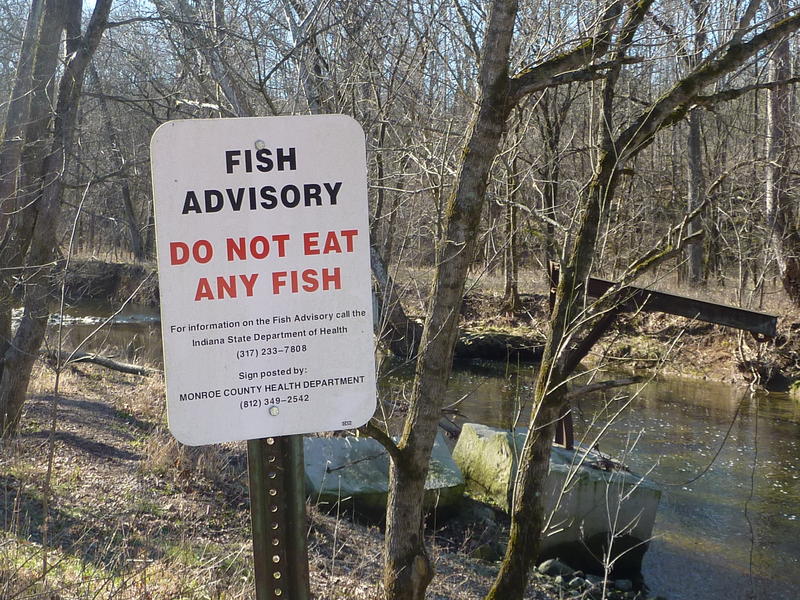
“Do Not Eat” Fish Advisory extended to Lake Erie
The Michigan Department of Health and Human Services (MDHHS) issued an expanded “Do Not Eat” Fish advisory due to PFAS contamination last week for all fish in the Huron River and several other bodies of water in Livingston, Oakland, Washtenaw, Wayne and Monroe Counties near Detroit.

A map of the Huron River and its watershed in southeastern Michigan, Image by Tim Kiser via wikimedia cc 3.0
The advisory extends from North Wixom Road in Oakland County – from the mouth of the Huron River – and goes all the way to the spot where the river enters Lake Erie in Wayne County.
PFAS are a group of chemicals used in products like Scotchguard and Teflon for waterproofing. They’re also used in fire-retardant sprays. The per-and polyflourinated compounds have been linked to cancer, liver damage, high cholesterol levels, birth defects and several autoimmune diseases. PFOS is a sub-group of PFAS.
Mlive obtained documents showing the source of the contamination in the Huron River is an industrial plating facility in Wixom that sent high levels of PFAS into a wastewater treatment plant. See story here: ![]()
Great Lakes Now talked with Angela Minicuci, spokesperson for the Michigan Department of Health and Human Services (MDHHS) to find out more about the “No Fish” Advisory in the Huron River. She says, “Originally, in early August, we issued an advisory based on some fish data we had received for portions of water bodies associated with the Huron River. Since that time, we’ve gotten additional surface water data. And then this past week, when we expanded it even more, we got some new fish data, and that data has shown there are high levels of PFOS in other areas as well. So, we’ve now expanded the Huron River advisory all the way up to north Wixom road in Oakland County and all the way down to Lake Erie in Wayne county.”
Minicuci says there are a number of other water bodies associated with the advisory, including several creeks and ponds and lakes off the Huron River as well.
“ All fish, all sizes, from all water bodies”
Minicuci tells Great Lakes Now, “The advisory applies to all fish of all sizes from all water bodies” listed in the report.
Minicuci explains, “PFAS is essentially a set of substances – various chemicals – that we’re concerned about. PFOS is the specific chemical we test for in fish. “
Great Lakes Now asked how the state checks for PFOS in fish. Minicuci says they test for PFOS in the actual flesh – the fillets – of fish – that would be eaten by humans. The DEQ works with the DNR to get the fish and then tests for chemicals in them. She says there’s a similar standard in rivers which compares to the EPA standard of 70 parts per trillion being unsafe in drinking water.
Minicuci says the advisory went out for the Huron River because, “Based on the levels we are finding in these fillets, we are concerned because they are consistently high. They are consistently elevated. They’re higher than what we would want in fish for those PFOS findings.” Minicuci says they compared levels in fish from 2016 to 2018 levels, and found the PFOS levels had soared to unsafe levels.
Minicuci tells Great Lakes Now MDHHS often finds multiple chemicals in fish, and there are often levels that require advisories that call for limiting your fish intake to “2 meals a month of a particular size or species of fish, or six meals a month, or once a year. But based on these new PFOS levels,” she says, “This is DO NOT EAT ANY FISH OF ANY SIZE. So, they’re extremely high. They’re extremely elevated for all of the fish fillets we’re getting back. And we want to make sure people apply this to any fish of any size they get out of the designated water bodies.” (For current guidelines relating to PFAS fish contamination, visit pfasresponse. For more information about the Eat Safe Fish guidelines, visit eatsafefish)
Minicuci says sport fishing – catch and release – can continue. And she says MDHHS is getting the word out to people who usually eat fish from the Huron River to refrain from consuming the fish they catch.
She says, “If people are recreationally fishing and not eating them, you can do that. We do NOT have a concern with touching the fish or touching the water. But we’ve been working with the counties, and over the weekend, to alert people not to eat the fish. We issued the advisory and put signs up along the river at all the locations. We also issued a press release and alerted the media.”
Minicuci says since PFAS was never designed to be consumed “there’s not a ton of data out there. What we do know, based on population level studies, is that we have seen impacts associated with growth, learning and behavior problems in young children, some issues associated with women getting pregnant, effects on hormones and cholesterol levels, and potential increases with certain types of cancer. But these are high levels of association. So, it’s really important that people get the message to not consume the fish.”
She says, “One of the biggest things is determining what the source is and once you find the source, then you can move forward with remediation. It’s not a quick solution. Not everything will be as fast as the Parchment situation. We were fortunate to have an option within the Parchment community – Kalamazoo’s municipal water. When you have a body as large as the Huron River, it’s a different story.”
Minicuci was referring to the recent month-long state of emergency in Parchment and Cooper township in Kalamazoo County, Michigan which began July 26th. Residents were told not to drink water coming from taps in their homes or businesses due to high levels – up to 20 percent higher than the 70 parts per trillion EPA levels – discovered in municipal water supplies. The state distributed bottled water until August 27th, when state studies showed the water was safe after the townships were switched to Kalamazoo’s water supplies. However, some private wells nearby still have high PFAS levels. Minicuci says residents with private wells with high PFAS levels have the option of being given state supplied NSF certified filter or bottled water that make their water safe to drink.
Minicuci says right now, there are more than 30 confirmed PFAS contaminated sites in Michigan but there are currently no drinking water states of emergency. She recommends visiting the state’s website to find out more, (Michigan.gov/pfasresponse) and even contacting your local health department if you’re worried about potential consumption of PFAS. She says, “What’s going in Wolverine is very different from what’s going on in Oscoda near Wurtsmith Airforce base. We’re trying our best to be active with all of the sites and get the word out to people immediately, just as we did with the Parchment situation.”
Great Lakes Now asked Minicuci if there are any cancer clusters or other clusters of diseases in areas where high PFAS contamination levels have been identified in Michigan. She said, “We did do a cancer incidence review for Kent county since there were high levels of PFAs there. And what we found is a small increase in prostate cancer. We are working with other communities to find out more. There is no science right now that can say if you are exposed to high levels of PFAS you will suffer certain affects. Based on a national CDC study, almost everyone has a minor level of PFAS in their bodies. “
Environmental activist and Oscoda County resident says it’s time for Michigan lawmakers to take action to stop the spread of PFAS contamination. He tells Great Lakes Now,” A bill to set a 5ppt PFAS drinking water limit remains stuck in committee in the Michigan House of Representatives almost 9 months after it was introduced by Rep. Winnie Brinks of Grand Rapids.The committee’s chairman, Rep. Gary Howell, now says there won’t even be a hearing on the bill (if at all) at least until after the election, and the Speaker of the House, Rep. Tom Leonard (who is running for attorney general) also supports continued inaction on the bill.”
Spaniola says, “If anything occurs in the “lame duck” legislative session after the election, it’s likely to be heavily influenced by the narrow special interests who have been riding rough-shod over Michigan’s outdated and inadequate PFAS regulatory scheme, the lowlights of which include: (1) No legally enforceable drinking water standard whatsoever for any PFAS substance; and (2) State decision making based on an EPA advisory of 70 ppt that is not protective of public health (particularly for children and pregnant women) and is 70 times higher than the limit of 1 ppt recommend by the Harvard School of Public Health.
Spaniola says legislators are playing politics with people’s health. He says, “Make no mistake, the delays in Lansing are purely political. Other states, like New Jersey and Vermont, have enacted much lower, enforceable PFAS drinking water limits, based extensive scientific studies and data. So, our so-called leaders in Lansing are not waiting for science; they’re waiting to get re-elected and kicking the can down the road for lame duck shenanigans. All the while, people across Michigan continue to ingest water that is not safe, particularly for the most vulnerable among us.”
3 Comments
-
Important article. Thank you. FYI, I think you’re missing a reference to Spaniola and his full name in this sentence…
Environmental activist and Oscoda County resident says it’s time for Michigan lawmakers to take action to stop the spread of PFAS contamination. -
There are ococysts present from goose poop. They have an incomplete DNA and are responsible for the mass called cancer and the seasonal illness called flu.
The pandemic of 1918 was caused by leptosporosis not a virus.
If you have had flu you have this parasite attached in your body. Cancer which just means mass is epidemic in lake Michigsn. It is in your drinking water. Enjoy drinking them. -
That’s the lake where most of the unsold, older model cars were dumped in the car manufacturing heyday. Production was key to the economy. No recycling only new. Flint is paying today. If you dance to the music you know you gotta pay to the piper.





